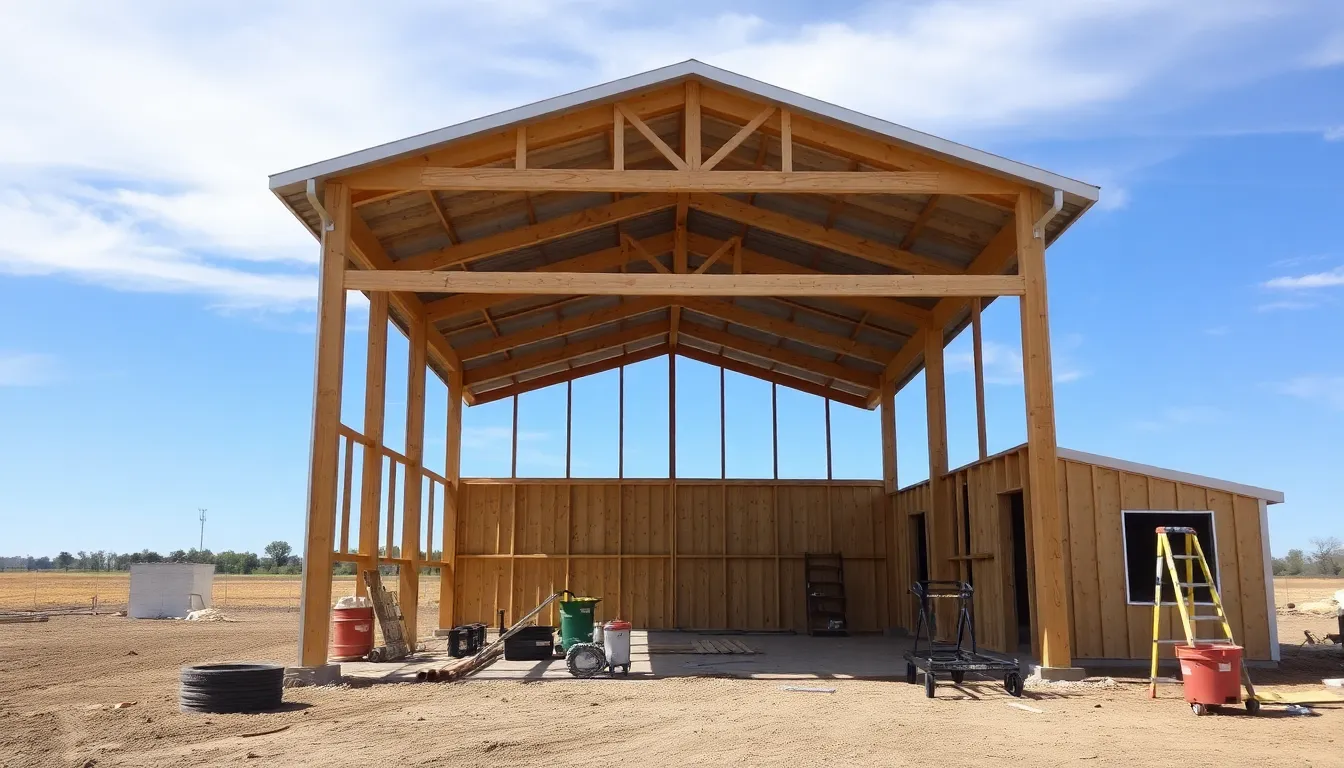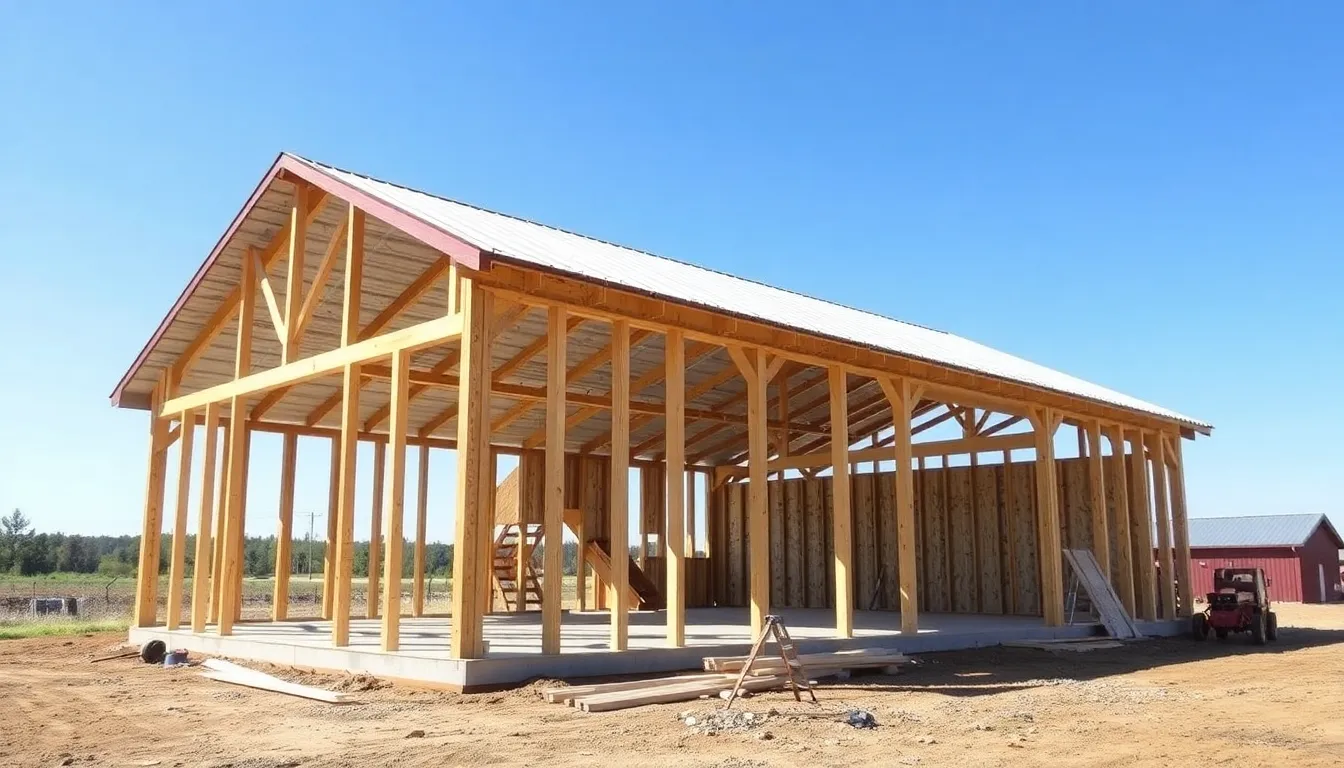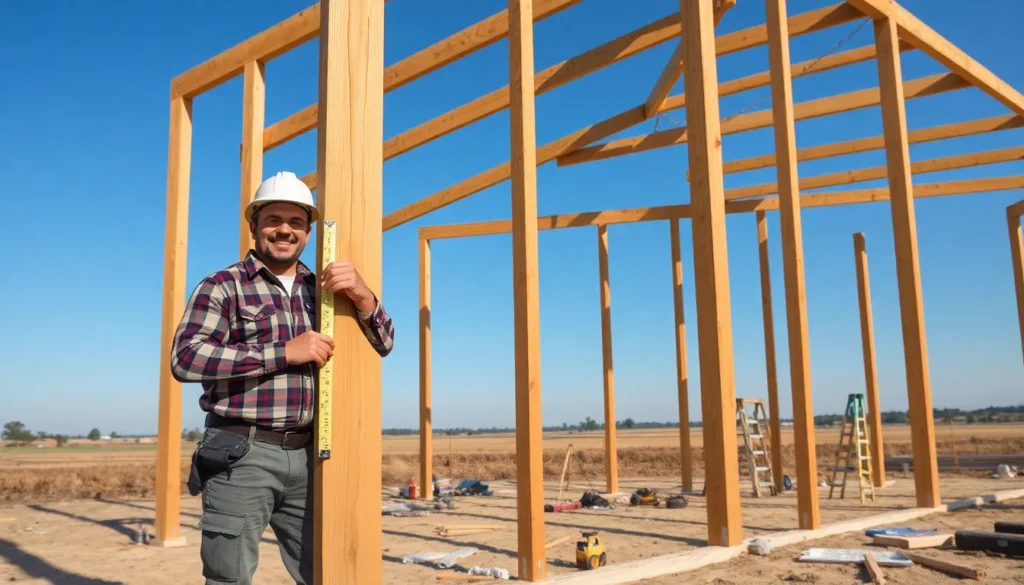Table of Contents
ToggleWhen it comes to building structures that stand the test of time, pole buildings are the unsung heroes of the construction world. These sturdy giants have become the go-to choice for everything from barns to workshops, and for good reason. With their unique design and cost-effective materials, they make construction feel less like a daunting task and more like a fun DIY project—minus the risk of accidentally turning your living room into a lumberyard.
Overview of Pole Building Construction
Pole building construction utilizes vertical poles as a structural framework. This method allows for open interior spaces without the need for interior load-bearing walls. Builders favor this approach for its efficiency and affordability during the construction process.
Materials play a crucial role in pole building construction. Typical components include treated wood poles, metal roofing, and siding materials. These materials resist harsh weather elements, contributing to long-lasting durability.
Many applications exist for pole buildings. They serve well as barns, workshops, storage facilities, and even commercial spaces. Such versatility leads to increasing popularity among homeowners and businesses.
The construction method is straightforward, making it suitable for DIY enthusiasts. Clear plans and kits are available, enabling builders to customize their structures. Tools required for construction include basic hand and power tools, ensuring accessibility for most people.
Energy efficiency remains a consideration in pole building design. Proper insulation and ventilation options enhance climate control inside these structures. Many builders integrate energy-efficient features during the construction phase to reduce utility costs.
Maintenance efforts can remain minimal with pole buildings. Regular inspections and simple upkeep procedures enhance longevity and function. Building with treated materials protects against decay and pest infestation.
Financing options for pole building construction are diverse. Many choose personal loans, savings, or financing through contractors. Various price points and configurations ensure that individuals or businesses can find suitable solutions for their needs.
Overall, pole building construction serves as a practical solution across many sectors. Its benefits include cost savings, flexibility, durability, and ease of construction.
Key Benefits of Pole Building Construction


Pole building construction offers several advantages that make it a preferred choice for various projects. Its cost benefits and resilience draw many towards this method.
Cost-Effectiveness
Cost-effectiveness marks one of the primary advantages of pole building construction. Building with treated wood poles and metal roofing significantly reduces material expenses compared to traditional methods. Lower labor costs also contribute to overall savings since the straightforward construction process minimizes required labor hours. Many individuals opt for DIY solutions, making the project even more affordable. Financing options are often available, which help manage budget constraints while initiating construction. Overall affordability enhances the appeal for homeowners and businesses alike.
Durability and Strength
Durability and strength rank among the critical attributes of pole buildings. The treated wood poles withstand harsh weather conditions and resist decay, ensuring longevity. Engineered to bear substantial loads, these structures offer stability without short-term maintenance issues. Unlike conventional buildings with load-bearing walls, pole buildings feature open interior spaces that enhance structural integrity. This design flexibility allows for customization, accommodating various uses such as storage or workshops. With minimal upkeep required, pole structures stand as an investment in robust and reliable construction.
Essential Materials for Pole Building Construction
Pole building construction relies on specific materials that ensure durability and functionality. Key components include poles and roofing solutions that contribute to the overall strength of the structure.
Types of Poles
Wooden poles form the backbone of pole buildings, offering excellent support. Treated wood poles resist decay, making them suitable for various climates. Steel poles present an alternative option, providing superior strength and longevity. When selecting poles, factors such as load requirements and environmental conditions play essential roles.
Roofing and Wall Options
Metal roofing remains a popular choice for pole buildings due to its longevity and low maintenance. It withstands harsh weather conditions while providing excellent insulation. Various wall options, including metal siding and wood boards, can enhance aesthetics and functionality. Insulated panels also offer energy efficiency, reducing heating and cooling costs. Each component plays a vital role in the resilience and performance of pole building structures.
Step-by-Step Guide to Pole Building Construction
Constructing a pole building involves specific steps to ensure its stability and functionality. Each phase is crucial, from site preparation to erecting the structure.
Site Preparation
Clearing the site involves removing debris, vegetation, and any obstacles. Surveying the terrain ensures proper drainage and foundation stability. Marking the building dimensions outlines where poles will be installed. Properly leveling the area allows for an even foundation. Staking out corners provides clear guidelines for future construction steps. Ensuring compliance with local zoning laws avoids delays or complications. It’s vital to choose a location that suits the intended use, maximizing convenience and access.
Erecting the Structure
Setting the poles is a key step in constructing a pole building. Digging deep holes for the poles ensures strong anchoring in the ground. Placing the poles vertically provides necessary support for the structure. Installing braces temporarily stabilizes the poles during construction. Attaching horizontal girts connects the poles, creating the framework for walls. Once the frame is secure, installing roof trusses supports the roofing material. Finally, adding roofing materials completes the structural integrity of the building, readying it for further construction phases.
Common Uses for Pole Buildings
Pole buildings serve diverse functions across various sectors due to their versatile design and durability. Many farmers utilize these structures as barns for livestock, equipment storage, or hay and feed storage. They accommodate ample space and easy access, meeting the demands of agricultural operations.
Contractors frequently turn to pole buildings for workshops, providing space for tools and machinery. Crafting a dedicated workspace enhances productivity while maintaining organization, proving beneficial for small businesses and hobbyists alike.
Retailers often adopt pole buildings for commercial use, recognizing the cost-effectiveness compared to traditional construction methods. These structures function as storefronts, allowing for ample display space while maintaining affordability.
In addition, homeowners appreciate pole buildings for garages or carports, providing protection from the elements. The open interior layout allows for customization, adapting to various vehicle sizes.
Outdoor recreational facilities also benefit from pole building construction. These structures can house sports equipment, provide shelter for gatherings, or function as community centers, offering flexibility in design for diverse activities.
Event venues, such as banquet halls or party spaces, highlight the adaptability of pole buildings. High ceilings and open layouts accommodate large groups easily, creating an inviting atmosphere for celebrations.
Ultimately, pole buildings offer endless possibilities, catering to agricultural, commercial, residential, and recreational needs. Their affordability, durability, and customizable nature position them as a preferred choice for a wide range of applications.
Pole building construction offers a practical solution for those seeking durability and versatility in their structures. With a straightforward construction process and a range of materials available, these buildings can be customized to fit various needs. Their cost-effectiveness and minimal maintenance make them an appealing option for both homeowners and businesses alike.
As interest in sustainable and efficient building methods grows, pole buildings stand out as a reliable choice. Whether for agricultural use, commercial spaces, or recreational facilities, the adaptability of pole buildings ensures they meet diverse demands. Investing in this construction method can lead to long-term benefits, making it a smart decision for anyone looking to build.







